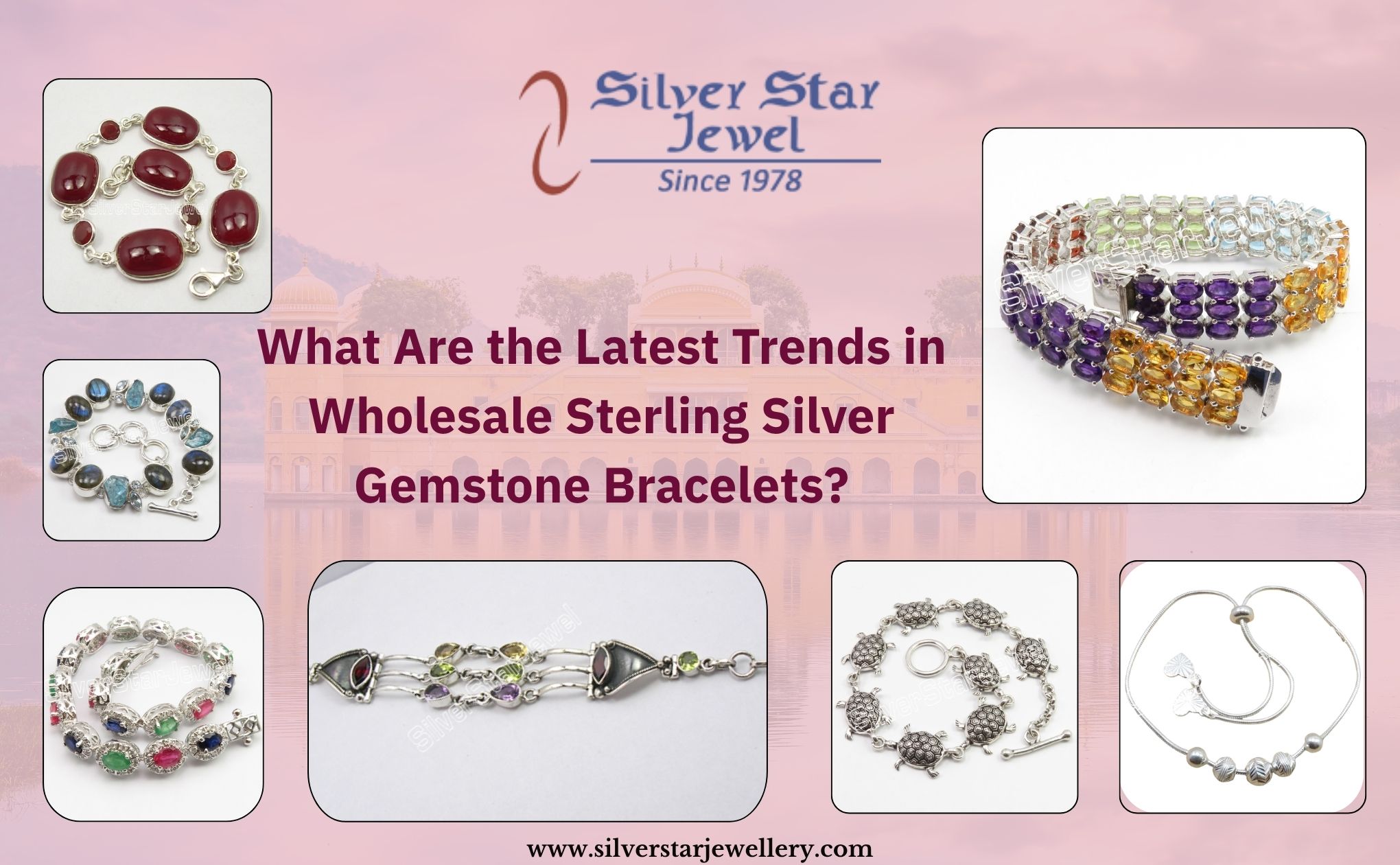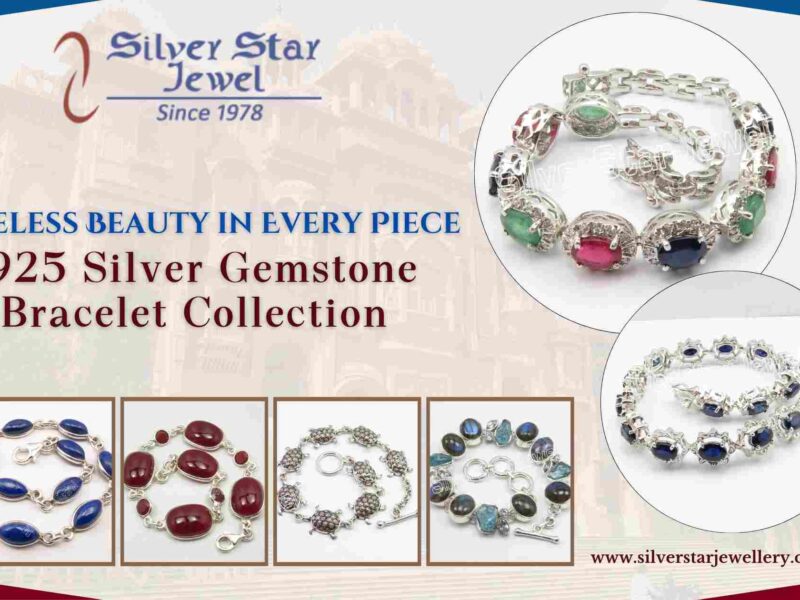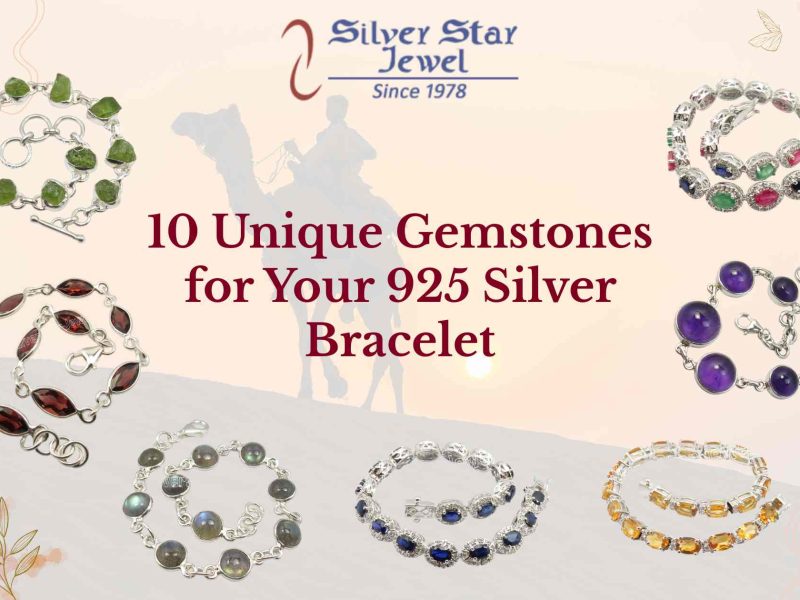Retailers in the jewelry sector face constant pressure to refresh inventory while balancing costs and customer appeal. In 2025, the focus shifts toward pieces that combine durability, aesthetic versatility, and ethical sourcing. Wholesale Sterling Silver Gemstone Bracelets stand out as a category that meets these demands, offering retailers a way to stock items that transition seamlessly from casual to formal settings. Businesses benefit from their relatively low production costs compared to gold alternatives, yet they command premium pricing due to the allure of natural stones. Suppliers prioritize alloys that resist tarnish, ensuring longer shelf life and fewer returns. This approach not only streamlines operations but also builds customer loyalty through reliable quality.
Market data indicates a 15 percent rise in demand for silver gemstone accessories this year, driven by younger demographics seeking personalized options. Retailers can leverage this by curating collections that highlight modular designs, allowing customers to mix elements for custom looks. Such strategies reduce overstock risks and increase average order values.
Key Trends Shaping the Market
Rise of Sustainable Sourcing Practices
Sustainability influences every aspect of jewelry procurement, with buyers scrutinizing supply chains for environmental impact. Gemstones now come from certified mines that adhere to fair labor standards, reducing the carbon footprint associated with extraction and transport. Retailers report a 20 percent sales uplift when marketing these details on product tags or online listings.
Operational benefits include access to bulk certifications that simplify compliance with regional regulations. Suppliers offer traceability reports, enabling businesses to verify origins without extensive audits. This transparency fosters trust, turning one-time buyers into repeat clients.
Emphasis on Mixed Metal Integrations
Designers blend sterling silver with gold plating or rose gold accents to create hybrid pieces that appeal to diverse tastes. These combinations allow bracelets to pair with existing wardrobes, broadening market reach. In practice, retailers stock versatile items that support cross-selling with other metal lines.
Production efficiencies arise from standardized plating processes that cut manufacturing time by up to 30 percent. This results in faster turnaround for custom orders, helping businesses respond to seasonal spikes without inventory buildup.
Personalization Through Modular Components
Customizable bracelets with interchangeable gemstone charms gain traction, as customers value items that reflect individual stories. Retailers implement in-store assembly stations, boosting engagement and dwell time. Data shows such features increase conversion rates by 25 percent in boutique settings.
From a business perspective, modular designs minimize waste during prototyping. Suppliers provide component kits at scaled pricing, allowing small retailers to test markets with minimal upfront investment.
Popular Design Innovations
Stackable and Layerable Configurations
Stackable bracelets dominate 2025 lineups, with slim profiles that encourage multiple wears. Retailers curate themed sets, such as ocean-inspired with aquamarine or earthy tones with malachite, to simplify purchasing decisions. These configurations enhance visual merchandising, drawing customers into deeper explorations of collections.
Practically, stackables reduce sizing issues since adjustable clasps fit various wrists. Inventory management improves as fewer variants need tracking, cutting administrative overhead by 10 to 15 percent.
- Select sets with varying widths for balanced layering.
- Pair with neutral packaging to highlight stone colors.
- Offer bundle discounts to promote higher volume sales.
Bold Gemstone Statements with Vibrant Hues
Vibrant stones like emerald and sapphire take center stage in oversized settings, shifting from subtle accents to focal points. Retailers position these as statement pieces for evening wear, capitalizing on social media shares that drive organic traffic.
Sourcing benefits include lower costs for semi-precious options over rare gems, maintaining margins above 50 percent. Durability testing ensures stones withstand daily use, lowering warranty claims.
Organic and Nature-Inspired Motifs
Freeform shapes mimicking leaves or waves incorporate textured silver for tactile appeal. These designs resonate with wellness-focused consumers, aligning with broader lifestyle trends. Retailers integrate them into eco-friendly displays to reinforce brand values.
Manufacturing leverages hand-finishing techniques that add unique imperfections, differentiating stock from mass-produced competitors. This artisanal touch justifies premium wholesale rates while appealing to niche markets.
Benefits for Retailers and Operations
Procuring wholesale handcrafted silver jewellery streamlines supply chains by emphasizing pieces made in small batches, which preserve intricate details without compromising volume. Businesses gain from consistent quality that supports branding as purveyors of authentic craftsmanship. Lead times shorten as artisans adapt to demand fluctuations, enabling just-in-time inventory practices.
Cost structures favor this category, with material expenses stable despite market volatility. Retailers achieve higher turnover rates, as handcrafted items sell out faster than generic alternatives. Integration with e-commerce platforms becomes straightforward, with detailed provenance stories enhancing product pages.
Wholesale Sterling Silver Gemstone Bracelets provide a competitive edge through their adaptability to fast fashion cycles. Retailers adjust offerings based on real-time sales data, minimizing unsold stock. Ethical production aligns with consumer preferences, potentially qualifying for green certifications that open new distribution channels.
As a trusted Wholesale Silver Gemstone Bracelets Supplier, Silver Star Jewel delivers collections that embody these trends, backed by decades of export expertise from Jaipur. Their low minimum orders of 50 pieces accommodate emerging brands, fostering long-term partnerships without financial strain.
Sourcing Strategies for Success
Effective sourcing starts with evaluating supplier reliability through sample kits that demonstrate finish quality and stone authenticity. Retailers negotiate tiered pricing based on annual commitments, locking in savings of 10 to 20 percent. Diversifying across two to three vendors mitigates risks from supply disruptions.
Digital tools aid in trend forecasting, allowing previews of upcoming designs months in advance. This proactive approach ensures shelves reflect current preferences, optimizing cash flow.
- Conduct quarterly audits of gemstone certifications.
- Track shipping metrics to refine logistics partners.
- Build relationships via virtual factory tours for transparency.
Wholesale handcrafted silver jewellery from specialized providers like Silver Star Jewel incorporates regional motifs that add cultural depth, appealing to global audiences. Their focus on 925 sterling ensures hypoallergenic properties, reducing customer complaints.
Integrating Trends into Business Models
To capitalize on these shifts, retailers should allocate 20 percent of jewelry budget to emerging styles like mixed metals. Training staff on styling advice enhances upselling, as informed recommendations lead to fuller baskets.
Analytics from point-of-sale systems reveal peak selling periods, guiding reorder timing. This data-driven method prevents overcommitment to fading trends, preserving profitability.
Wholesale Sterling Silver Gemstone Bracelets fit neatly into subscription boxes, offering subscribers quarterly updates that encourage retention. Businesses report 15 percent higher loyalty rates with such programs.
Must Read: How MultiStone Necklaces Manufacturers and Turquoise Earring Wholesalers Shape Jewelry Trends
Future Outlook
Looking ahead, advancements in alloy treatments promise even greater tarnish resistance, extending product lifespans. Retailers preparing now can secure exclusive designs, positioning ahead of competitors.
Wholesale handcrafted silver jewellery will likely incorporate smart elements, like embedded trackers for lost items, appealing to tech-savvy users. Early adoption yields first-mover advantages in pricing and marketing.
As demand stabilizes, suppliers refine offerings to include more inclusive sizing, broadening accessibility.
Frequently Asked Questions
Q1. What factors determine the quality of wholesale sterling silver gemstone bracelets?
Ans: Quality hinges on the purity of the 925 sterling silver alloy and the authenticity of gemstones, verified through certifications like those from the Gemological Institute of America. Retailers should request batch testing reports to ensure consistency across orders.
Q2. How can retailers minimize risks when sourcing wholesale handcrafted silver jewellery?
Ans: Start with small trial orders to assess craftsmanship and delivery reliability. Diversify suppliers and include clear return policies in contracts to protect against defects or delays.
Q3. What are the typical minimum order quantities for a wholesale silver gemstone bracelets supplier?
Ans: Most suppliers set minima at 50 to 100 pieces, allowing flexibility for small businesses. Providers like Silver Star Jewel maintain low thresholds to support startups without excessive upfront costs.
Q4. How do current trends affect pricing for wholesale sterling silver gemstone bracelets?
Ans: Trends like sustainable sourcing may increase costs by 5 to 10 percent due to ethical premiums, but volume discounts offset this. Retailers benefit from stable silver prices around $30 per ounce in 2025.
Q5. What operational tips help integrate wholesale handcrafted silver jewellery into retail inventory?
Ans: Use inventory software to track trends and automate reorders. Focus on versatile pieces that support multiple styling options to maximize display efficiency and sales velocity.



